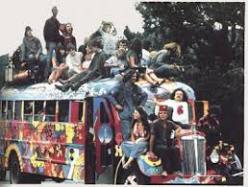






The American Counterculture refers to the period between 1964-1972 when the norms of the 1950s were rejected by youth.
Key Points
◾Counterculture youth rejected the cultural standards of their parents, especially with respect to racial segregation, the Vietnam War, sexual mores, women’s rights, and materialism.
◾Hippies were the largest countercultural classification comprising mostly white members of the middle class.
The counterculture movement divided the country.
◾The movement died in the early 1970s because most of their goals had become mainstream, and because of rising economic troubles.
Terms
◾quash
To defeat forcibly.
◾stagflation
Inflation accompanied by stagnant growth, unemployment or recession.
◾counterculture
Any culture whose values and lifestyles are opposed to those of the established mainstream culture, especially to western culture.
A counterculture developed in the United States in late 1960s. This movement lasted from approximately 1964 to 1972, and it coincided with America’s involvement in Vietnam. A counterculture is the rejection of conventional social norms – in this case the norms of the 1950s . The counterculture youth rejected the cultural standards of their parents, specifically racial segregation and initial widespread support for the Vietnam War.
Woodstock Youth

This photo was taken near the Woodstock Music Festival in August, 1969. The counterculture in the 1960s was characterized by young people breaking away from the traditional culture of the 1950s.
As the 1960s progressed, widespread tensions developed in American society that tended to flow along generational lines regarding the war in Vietnam , race relations, sexual mores, women’s rights, traditional modes of authority, and a materialist interpretation of the American Dream. White, middle class youth, who made up the bulk of the counterculture, had sufficient leisure time to turn their attention to social issues, thanks to widespread economic prosperity.
Vietnam War Protest

The counterculture of the 1960s was marked by a growing distrust of government
, which included anti-war protests like this.
Unconventional appearance, music, drugs, communitarian experiments, and sexual liberation were hallmarks of the sixties counterculture, most of whose members were white, middle-class young Americans. Hippies became the largest countercultural group in the United States . The counterculture reached its peak in the 1967 “Summer of Love,” when thousands of young people flocked to the Haight-Ashbury district of San Francisco. The counterculture lifestyle integrated many of the ideals and indulgences of the time: peace, love, harmony, music, and mysticism. Meditation, yoga, and psychedelic drugs were embraced as routes to expanding one’s consciousness.
The Peace Sign

The peace sign became a major symbol of the counterculture of the 1960s.
Rejection of mainstream culture was best embodied in the new genres of psychedelic rock music, pop-art, and new explorations in spirituality. Musicians who exemplified this era include The Beatles, The Grateful Dead, Jefferson Airplane, Jimi Hendrix, The Doors, The Rolling Stones, Neil Young, Bob Dylan, Janis Joplin, and Pink Floyd.
New forms of musical presentation also played a key role in spreading the counterculture, mainly large outdoor rock festivals. The climactic live statement of this occurred from August 15–18, 1969, with the Woodstock Music Festival held in Bethel, New York. During this festival, 32 of rock and psychedelic rock’s most popular acts performing live outdoors over the course of a weekend to an audience of half a million people.
Countercultural sentiments were expressed in song lyrics and popular sayings of the period, such as “do your own thing,” “turn on, tune in, drop out,” “whatever turns you on,” “eight miles high,” “sex, drugs, and rock ‘n’ roll,” and “light my fire. ” Spiritually, the counterculture included interest in astrology, the term “Age of Aquarius,” and knowing people’s signs.
The counterculture movement divided the country. To some Americans, these attributes reflected American ideals of free speech, equality, world peace, and the pursuit of happiness. To others, the counterculture movement reflected a self-indulgent, pointlessly rebellious, unpatriotic, and destructive assault on America’s traditional moral order.
In an effort to quash the movement, authorities banned the psychedelic drug LSD, restricted political gatherings, and tried to enforce bans on what they considered obscenity in books, music, theater, and other media. In the end, the counterculture collapsed on its own around 1973.
Two main reasons are cited for the collapse. First, the most popular of the movement’s political goals—civil rights, civil liberties, gender equality, environmentalism, and the end of the Vietnam War—were accomplished (to at least a significant degree), and its most popular social attributes, particularly a “live and let live” mentality in personal lifestyles (the “sexual revolution”)—were co-opted by mainstream society. Second, a decline of idealism and hedonism occured as many notable counterculture figures died and the rest settled into mainstream society and started their own families.
The “magic economy” of the 1960s gave way to the stagflation of the 1970s, the latter costing many middle-class Americans the luxury of being able to live outside conventional social institutions. The counterculture, however, continues to influence social movements, art, music, and society in general, and the post-1973 mainstream society has been in many ways a hybrid of the 1960s establishment and counterculture—seen as the best (or the worst) of both worlds.
0.000000
0.000000

















